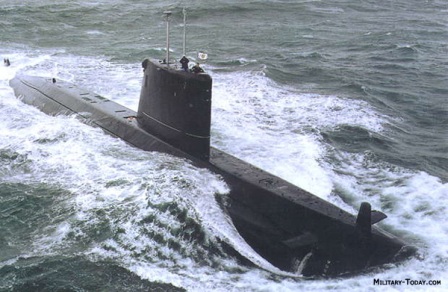Agosta-class
Summary
| Origin country | 🇫🇷 France |
| Category | Submarine |
| Subtype | Attack submarine |
| Manufacturer | DCN, Cherbourg |
| Year commissioned | 1977 |
| Units |
S135 PNS Hashmat S136 PNS Hurmat S137 PNS Khalid S138 PNS Saad S139 PNS Hamza |
| Current operators | 🇵🇰 Pakistan |
Description
The Agosta-class submarine is a French diesel-electric attack submarine developed in the 1970s by DCNS (formerly known as Direction des Constructions Navales Services) to replace the Daphné-class submarines. They were designed for ocean-going capabilities, indicating their extended operational range. These submarines saw service in several navies including France, Spain, and Pakistan, and one unit served as a training vessel in the Royal Malaysian Navy. The submarines were superseded in French service by the Rubis-class nuclear attack submarines, though they continue to serve in other countries.
The key missions of the Agosta-class included traditional attack roles against surface and underwater targets, surveillance, and patrol operations in the high seas. They were well-suited for maritime defense and could engage in long-range missions. The Agosta-class submarines' role in the Cold War included deployments to the Arabian Sea to counterbalance the Indian Navy.
The class is named after its lead unit, Agosta, which itself was named after the 1676 Battle of Augusta. Four units were commissioned in the French Navy including Agosta, Bévéziers, La Praya, and Ouessant, with all except Ouessant being decommissioned between 1997 and 2000. The Spanish Navy had four units, with the last being decommissioned in 2020, while the Pakistan Navy continues to operate two of these submarines – renamed PNS/M Hashmat and PNS/M Hurmat, referred to as the Hashmat Class.
South Africa intended to acquire Agosta-class submarines, with agreements underway in the 1970s, but the transaction was halted due to an international arms embargo against the apartheid regime. Consequently, the units were instead sold to Pakistan.
The operational history of the Agosta-class includes deployment in the Arabian Sea during the 1983-1985 period to deter Indian naval actions. The class also conducted operations to test their submerged endurance and operational reach in the Indian Ocean.
An improved variant, the Agosta-90B, features advanced technologies, higher performance in terms of endurance and stealth, and reduced crew requirements. This variant, capable of carrying a broader range of armaments including torpedoes, SM39 Exocet anti-ship missiles, and potentially even seaborne nuclear cruise missiles, was developed and offered to Pakistan, resulting in technology transfer and the construction of submarines with French assistance. Three such units are in service with the Pakistan Navy, namely PNS/M Khalid, PNS/M Saad, and PNS/M Hamza, with the SM39 missile successfully test-fired from Khalid-class in 2001.
The Agosta-class has undergone upgrades, notably a 2018 contract awarded to the Turkish firm STM for mid-life enhancements that included sonar systems, periscopes, command and control systems, and radar and electronic support systems among other improvements. The upgrade also encompassed HAVELSAN and ASELSAN systems, SharpEye radar installation, and structural modifications.
Technical specifications
| Displacement | 1510 tons |
| Displacement submerged | 1760 tons |
| Range | 13000 km |
| Crew | 41 members |
| Width | 6.0 m (19.7 ft) |
| Length | 67.0 m (219.8 ft) |
| Max. depth | 250 m (820.2 ft) |
| Propulsion | 2 SEMT Pielstick 16 PA 4 diesel engines with a power of 1,160 hp - 1 propeller |
| Armament | 4 533mm torpedoes (with 16 torpedoes/missiles). |
| Maximum speed | 12 knots |
| Max. speed submerged | 21 knots |
